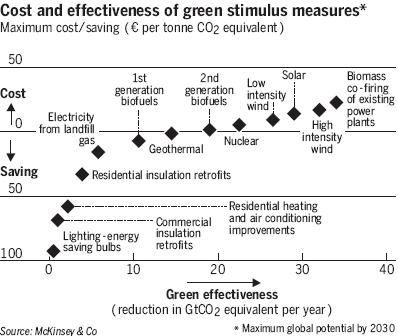
I stumbled upon a very simple chart today, one that gives us an interesting analysis of energy saving and the best way to do it. It's a chart published in the Financial Times to go with an article called "Advantages of Frugal Fuel". It by McKinsey & Co and shows the green effectiveness of a number of common green energy technologies. Any technology below the zero line shows a technology that not only reduces CO2 emissions, but will also save you more money than it costs over its lifetime.
It clearly illustrates that using energy efficient light bulbs and insulating walls is the best, cheapest and most cost effective "green stimulus measures". Forget the solar panels, the wind-power or even geo-thermal. Just change your light bulbs and insulate your walls and you're doing far better than investing in any other technologies.
Should we be spending massive amounts of money on new power stations, wind-farms or just ensuring that we all get more energy efficient by changing our filament light bulbs and insulating our walls. Amazingly, the money should be going on bulbs and insulation! And almost astonishingly, the EU recognises this; Andris Piebalgs, the commissioner in charge of energy said "Energy efficiency is the cheapest and most effective way to reduce energy policy risks".
So, for all of you planning green data-centres, virtualisation or thin-client desktop rollouts think again, you should actually be just planning to swap your light bulbs, insulate your walls and make all your friends do the same. I'm kind of joking, but it does make it very clear that you shouldn't be taking such measures for altruistic reasons alone, it needs to significantly improve the company's bottom line!